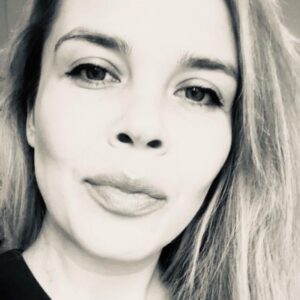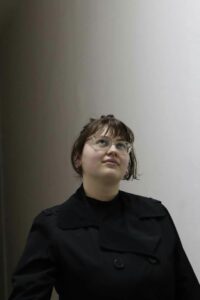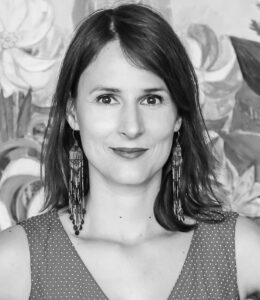Viktória Monhor

– born 1989. Most of Viktória Monhor’s works are reflections on Hungarian social, political and public topics, mostly through the medium of performance. She considers artistic activity as an extended social practice that, as the field of free thinking, is able to articulate a critical attitude. ** Including her dual identity arising from her family roots, as well as personal, family life situations in the creative process constitutes another pillar of her artistic practice. ** She considers the “official” artistic profession, the existence of an artist – insofar as it is not applied arts and works of a decorative nature – to be a kind of statement in itself due to the existential unpredictability undertaken with it.
Art was originally a tool for the magical fight against evil, harmful forces. – Miklós Erdély
0. Make a statement1
I graduated from the Intermedia Department of the Hungarian University of Fine Arts in 2020. One of the possible versions of my diploma thesis was the summary of the years spent at the university, thinking about art and art practice, which would have taken the form of lecture-performance2. I consider self-reflection to be one of the essential pillars of art practice – and human existence at the same time. I treat the statement as a space of thought, a mixture of swirling self-explanations, feelings, conscious and unconscious motives, for which I do not consider writing to be the most adequate form.
I. Roots
I was born in Budapest in 1989. My mother is Hungarian and my father is of Mongolian descent. I grew up in Hungary, I didn’t come into close contact with Mongolian culture either as a child or as an adult, family stories also came up only occasionally. This dual identity, the obscurity that covers my family roots, and the thinking about my affiliation play an important role in my personal story.
As part of the Ludwig Grant3, I had the opportunity to look for my relatives. It is a strange similarity that while in Hungary I was treated as tourists in many situations, I was not at home in Mongolia either, as beyond the language barriers, I did not grow up there.
Incorporating family heritage and family life situations into my creative process constitutes one of the pillars of my artistic practice. In my case, this is a difficult question, as some of my close family members consider artistic practice as useless, or tolerate it as a hobby, a form of entertainment in the best case. My journey towards an intermediate artistic practice and a holistic approach can thus be interpreted as a history of rebellion, from my compulsory – family-expected – serious degree4 to my art history5 and practice based art education6 until my presence as a freelance cultural worker. This personal background also inspires my artistic manifestations of a more provocative character.
II. Roots
I come from an acting background, having attended regular (physical)theatre workshops since I was a teenager. This interest varies in intensity, but still exists today. We can say that the conversion of my opinion into performative actions and performances came naturally in terms of genre. I see art as a field of radical freedom.
III. Food
The soil from which (mostly) performances emerge is composed of read, seen, heard, experienced, inexperienced and other influences: fluxus, Joseph Beuys, Miklós Erdély, INDIGO, dump days, found objects and scores, sound and movement art, Marcel Duchamp, Japanese and Chinese tea culture, Yves Klein, presence in various fields, alternative theatre, absurd humour, Dick Higgins, permaculture, Sylvia Plath, Hungarian-Mongolian roots, organization, shorthand writing, working clothes from rural second-hands, irony, costumes, silence, popping up scores; There is the play of ideas, the playfulness of free experimentation, the playfulness of free association and the play of paradigm shifting that are as common to scientific experiment as to pranks7; contemporary Russian and Hungarian literature, reducing the ecological footprint, mingling with unknown people, Krétakör: Feketeország [Black Land]8, a word, a phrase, a sentence – anything at any time. Democracy of fluxus scores. Simplicity.
IV. Doubt
Questioning my belief in art tends to break out in waves. I bounce between the endpoints of it makes no sense and only this makes sense. I have no compulsion to create something all the time9. Art and life are part of a unified field of reference10. Kunst kennt keine Wochenende11.
I do not consider working in art as a way to create an existence through the production of artwork, but as a free field that allows me to find a way out from ingrained mindsets. Work, art, art work: during my university years it already became clear to me that to make a living from art is a utopian thought, it is essential to have a B, C, Z plan, in my case the threads always ran in parallel.
V. Finding the path from today’s world to a democratic world12.
My reflections on current political events in Hungary are born of a mixture of necessity and chance. From a kind of inner necessity that does not always and not necessarily take an artistic form. Since I was born in 1989, I have no personal experience of the previous regime. The misty space shaped by mandatory school celebrations and rarely heard family stories is a terrain of uncertainty, a disturbingly obscure legacy. Resulting from this, there was a time when I made dumpster diving my habit: former official documents, brigade diaries, family photos, correspondence, clothes were the bulk of the things I took home. For the time being, the collection is waiting in boxes as a time capsule.
The current two-thirds political field of (violent) force, the lack of discourse on the regime that preceded the change of regime and on the change of regime itself do not help to dissipate the historical fog either. In our strong and proud illiberal democracy, or in this human experiment happening in the shadow of a climate catastrophe, we are wallowing in a swamp spiced with years of prevailing hatemongering in the company of recent past, historical traumas; 27% VAT; Hungarian declining in number; the mother is a woman, the father is a man13; stop Brussels poster-mantras and more14. One way or another, many see it as their duty to respond, not to mention that toxic tension needs to be drained away. I am also one of the those who sometimes shout stop15 from the swamp1617181920212223.
The final version of the statement was realized in collaboration with art historian Róna Kopeczky (2021).
1Art has no alternative, 2015, exhibition, tranzit.sk. See: https://sk.tranzit.org/en/exhibition/0/2015-01-09/art-has-no-alternative.2Finally, I chose to realise version C with my diploma work Fictional, non-fictional, 2018-2020. See: https://viktoriamonhor.hotglue.me/?fictivenotfictive.
3Application for the Peter and Irene Ludwig Foundation Grant, 2017. At the end of the project, I re-enacted a Mongolian tradition related to becoming an adult, the so-called first haircut ceremony, in the frame of the performance/celebration entitled Daah urgeeh, 2018. See: https://viktoriamonhor.hotglue.me/?daahurgeeh.
4Budapesti Corvinus University, social studies, with a specialization in equal opportunities.
5Eötvös Loránd University, Faculty of Humanities, Art History and Aesthetics.
6Hungarian University of Fine Arts, Department of Intermedia, and three semesters abroad: University of Nova Gorica, media art and the Hochschule für Grafik und Buchkunst, media art.
7Ken Friedman, Twelve Fluxus Ideas. See: http://unidcom.iade.pt/radicaldesignist/wp-content/uploads/2015/07/001_07.pdf.
8Krétakör Theatre's satirical vision of the world we live in from 2004. See: http://schillingarpad.com/work/136.
9At the same time Robert Filliou’s term/thought on permanent creation: Permanent creation is a creative action model that was summarized by Filliou in 1978 as follows: Do anything, do anything else, think in any way, think else! See: https://www.sepsiszentgyorgy.info/component/content/article?id=234:mveszet-szueletesnapja.
10Ken Friedman, Twelve Fluxus Ideas, see: http://unidcom.iade.pt/radicaldesignist/wp-content/uploads/2015/07/001_07.pdf.
11Peter Weibel.
12Ken Friedman, Twelve Fluxus Ideas, see: http://unidcom.iade.pt/radicaldesignist/wp-content/uploads/2015/07/001_07.pdf.
13Image: Viktória Monhor, Hommage à Marcel Duchamp, 2020, photo Zoltán Balla. Courtesy of the artist. See: https://viktoriamonhor.hotglue.me/?2.
14InsightHungary – Business, politics and important stories from 444, an independent Hungarian online news site. See: https://insighthungary.444.hu/.
15Image: Viktória Monhor, Danger Music #17, 2014, in the frame of Living Monument, see: https://viktoriamonhor.hotglue.me/?dangermusic17.
16Image: Viktória Monhor, daah urgeeh performance, video still, 2018. Courtesy of the artist.
17Image: Viktória Monhor, from the “TIMEBASE” exhibition catalogue, New Budapest Gallery, 2016-2016. Courtesy of the artist.
18Image: Viktória Monhor, I don’t think it’s a revolution, 2020, matchbox, photo Dániel János Fodor. Courtesy of the artist.
19Image: Igor and Ivan Buharov, Eternal Intentionfield Tuning, 2019, photo Zsuzsanna Simon. Courtesy of the artists.
20Image: Igor and Ivan Buharov, Eternal Intentionfield Tuning, 2019, photo Zsuzsanna Simon. Courtesy of the artists.
21Image: Viktória Monhor, Orange Magic, 2019, photo Dániel János Fodor. Courtesy of the artist.
22Image: Viktória Monhor, Sound performance with Zopán Nagy and Katalin Ladik, 2019, photo Dóra Halasi. Courtesy of the artists.
23Image: TÁP Theatre, Bajuss – Freak Show, 2018, still. Courtesy of the artists.
– szül. 1989 – munkáinak többsége hazai társadalmi, politikai, közéleti ügyekre adott reflexió, többnyire a performansz médiumán keresztül. A művészeti tevékenységre olyan kiterjesztett társadalmi gyakorlatként tekint, mely a szabad gondolkodás terepeként érvényes kritikai attitűd megfogalmazására képes. ** Családi gyökereiből adódó kettős identitás; személyes, családi élethelyzetek egy-egy alkotási folyamatba való beemelése képezi művészeti praxisa másik pillérét. ** A művészettel való „hivatalos” foglalkozást, a művész-létet – amennyiben nem alkalmazott művészetről és dekorációs jellegű alkotásokról van szó – az ezzel vállalt egzisztenciális kiszámíthatatlanság miatt önmagában is egyfajta statementnek tekinti.
A művészet eredetileg a rossz, kártékony erők elleni mágikus harc eszköze volt. – Erdély Miklós
0. Make a statement1
2020-ban diplomáztam a Magyar Képzőművészeti Egyetem Intermédia Tanszékén. Diplomamunkám egyik lehetséges verzióját az egyetemen töltött évek összegzése, a művészetről, művészeti gyakorlatról való gondolkodás jelentette, mely lecture-performance formában öltött volna testet2. Az önreflexiót a művészettel való foglalkozás – és egyben az emberi létezés – egyik elengedhetetlen pillérének tartom. A statementet egy olyan gondolati térként kezelem, mely kavargó ön-fejtegetések, érzetek, tudatos és tudattalan indítékok elegye, melyhez nem az írást tartom a legadekvátabb formának.
I. Gyökerek
Budapesten születtem, 1989-ben. Édesanyám magyar, édesapám mongol származású. Magyarországon nőttem fel, a mongol kultúrával sem gyermekként, sem felnőttként nem kerültem közelebbi kapcsolatba, a családi történetek is csak néha kerültek elő. E kettős identitás, a családi gyökereket fedő homály és a hovatartozásomról való gondolkodás fontos szerepet játszik személyes történetemben.
A Ludwig ösztöndíj3 keretében lehetőségem nyílt felkutatni rokonaimat. Furcsa hasonlóság, hogy míg Magyarországon sok helyzetben turistaként kezelnek, addig Mongóliában sem voltam otthon, hiszen a nyelvi akadályokon túl nem ott nőttem fel.
A családi örökség, családi élethelyzetek egy-egy alkotási folyamatba való beemelése képezi művészeti praxisom egyik pillérét. Esetemben ez nehéz terep, mivel a művészettel való foglalkozást a közeli családtagok egy része haszontalannak, jobb híján tűrtnek, hobbinak, szórakozásnak tekinti. Az intermediális művészeti gyakorlathoz, holisztikus szemlélethez vezető út tehát lázadástörténetként is értelmezhető, így a kötelező, – családilag elvárt – komoly diplomától4 a művészettörténeti5 és művészeti képzésen6 keresztül a szabadúszó kultúrmunkásként való jelenlétemig. Ez a személyes háttér is inspirálja provokatívabb jellegű művészeti megnyilvánulásaim.
II. Gyökerek
A színészet felől érkeztem: tizenéves koromtól kezdve rendszeresen részt vettem (mozgás)színházi workshopokban. Ez az érdeklődés változó intenzitással, de jelenleg is fennáll. Mondhatni, hogy műfajilag adta magát véleményem performatív akciókká, performanszokká való konvertálása. A művészetet a radikális szabadság terepének tartom.
III. Táplálék
Olvasott, látott, hallott, tapasztalt, nem tapasztalt és egyéb hatások által képződő talaj, melyből (többnyire) performanszok bukkannak elő: fluxus, Joseph Beuys, Erdély Miklós, INDIGO, lomtalanítás, talált tárgyak és partitúrák, hang- és mozgásművészet, Marcel Duchamp, japán és kínai teakultúra, Yves Klein, különböző területeken való jelenlét, alternatív színház, abszurd humor, Dick Higgins, permakultúra, Sylvia Plath, magyar-mongol gyökerek, szervezés, gyorsírás, munkaruhák vidéki turkálókból, irónia, jelmezek, csend, felbukkanó partitúrák; Vannak játékos gondolatok, játékos a szabad kísérletezés, a szabad asszociáció és a paradigmaváltás, amely a tudományos kísérletnek éppúgy jellemzője, mint a viccnek7; kortárs orosz és magyar irodalom, ökológiai lábnyomom csökkentése, beszédbe elegyedés ismeretlen emberekkel, Krétakör: Feketeország8, egy-egy szó, kifejezés, mondat – bármikor bármi. A fluxus partitúrák demokratikussága. Egyszerűség.
IV. Kétely
Hullámokban szokott előtörni a művészetbe vetett hitem megkérdőjelezése. A semmi értelme és a csak ennek van értelme végpontok között ugrálok. Nincs bennem kényszer, hogy folyamatosan létrehozzak valamit9. A művészet és az élet egy egységes referenciamező10. Kunst kennt keine Wochenende11.
A művészeti munkát nem mű-gyártásnak tekintem, hanem egy szabad mezőnek, amely teret nyit a megszokott gondolkodási sémákból való kiszakadásnak. Munka, művészet, művészeti munka: már az egyetemi évek alatt világossá vált, hogy a művészetből megélni egy utópikus gondolat, kell egy B, C, ZS terv, nálam mindig párhuzamosan futottak a szálak.
V. Meg kell találnunk az utat, amely a mai világtól a demokratikus világig vezet12.
A hazai, aktuálpolitikai történésekre adott reflexióim a szükségszerűség és a véletlen keverékéből születnek. Egyfajta belső szükségszerűségből, mely nem mindig és nem feltétlen művészeti formában ölt testet. Mivel 1989-ben születtem, az előző rendszerről nincs személyes élményanyagom. A kötelező iskolai ünnepségek, a ritkán előkerülő családi történetek által formált ködös tér a bizonytalanság terepe, zavaróan homályos örökség. Ebből is ered, hogy egy időben sportot űztem a lomtalanításból: egykori hivatalos iratok, brigádnaplók, családi fotók, levelezések, ruhák képezték a hazavitt dolgok java részét. A gyűjtemény egyelőre – időkapszulaként – dobozokban várakozik.
A fennálló kétharmados politikai erő(szak)tér, a hazai, rendszerváltás előtti rendszerről és magáról a rendszerváltásról folytatott diskurzus hiánya sem segít a történelmi köd oszlásában. Erős és büszke illiberális demokráciánkban, avagy ebben a klímakatasztrófa árnyékában zajló emberkísérletben az évek óta fennálló gyűlöletszítással fűszerezett mocsárban dagonyázunk a közelmúlt, a történelmi traumák; a 27% áfa; fogy a magyar; az anya nő, az apa férfi13; állítsuk meg Brüsszelt, plakát-mantrák és egyebek társaságában14. Így vagy úgy, sokan kötelességüknek tekintik, hogy reagáljanak, arról nem beszélve, hogy a mérgező feszültséget le kell vezetni. Én is a mocsárból néha megálljt kiáltó15 emberek közé tartozom1617181920212223.
A statement végleges formája Monhor Viktóra és Kopeczky Róna művészettörténész együttműködésében jött létre (2021).
1Art has no alternative c. kiállítás, tranzit.sk, 2015. Lásd: https://sk.tranzit.org/en/exhibition/0/2015-01-09/art-has-no-alternative.2Végül a C verzió valósult meg Fiktív, nem fiktív c. diplomamunkámmal, 2018-2020. Lásd: https://viktoriamonhor.hotglue.me/?fictivenotfictive.
3Peter és Irene Ludwig Alapítvány ösztöndíj pályázata, 2017. A projekt lezárásaként a Daah urgeeh c. performansz/ünnep keretében egy felnőtté-váláshoz kapcsolódó mongol hagyományt pótoltam, az ún. első hajvágási ceremóniát, 2018. Lásd: https://viktoriamonhor.hotglue.me/?daahurgeeh.
4Budapesti Corvinus Egyetem, társadalmi tanulmányok, esélyegyenlőség szakirány.
5Eötvös Loránd Tudományegyetem, Bölcsészettudományi Kar, művészettörténet-esztétika.
6Magyar Képzőművészet Egyetem, Intermédia Tanszék és három külföldön töltött szemeszter: University of Nova Gorica, médiaművészet és a Hochschule für Grafik und Buchkunst, médiaművészet.
7Ken Friedman: Fluxus és társai. Lásd: https://artpool.hu/Fluxus/Friedman/Fluxushu9.html.
8Lásd: http://schillingarpad.com/work/136.
9Egyúttal Robert Filliou állandó alkotás (permanent creation) gondolata. Az állandó alkotás egy olyan kreatív cselekvésmodell, amelyet Filliou 1978-ban így foglalt össze: „bármit teszel, tegyél valami mást, bárhogy vélekedsz, vélekedj másképp." Lásd: https://www.sepsiszentgyorgy.info/component/content/article?id=234:mveszet-szueletesnapja.
10Ken Friedman: Fluxus és társai. Lásd: https://artpool.hu/Fluxus/Friedman/Fluxushu8.html.
11Peter Weibel.
12 Ken Friedman: Fluxus és társai. Lásd: https://artpool.hu/Fluxus/Friedman/Fluxushu7.html.
13kép: Monhor Viktória, Hommage à Marcel Duchamp, 2020, fotó Balla Zoltán. A művész jóvoltából. Lásd: https://viktoriamonhor.hotglue.me/?2.
14InsightHungary – Biznisz, politika és fontos történetek a 444 független magyar online hírportáltól, lásd: https://insighthungary.444.hu/.
15kép: Monhor Viktória, Danger Music #17, 2014, az Eleven Emlékmű keretében, lásd: https://viktoriamonhor.hotglue.me/?dangermusic17.
16kép: Monhor Viktória, daah urgeeh performansz, állókép a videóból, 2018. A művész jóvoltából.
17kép: Monhor Viktória, az “IDŐALAP” című kiállítás katalógusából, Új Budapest Galéria, 2016-2016. A művész jóvoltából.
18kép: Monhor Viktória, I don’t think it’s a revolution, 2020, gyufásdoboz, fotó Fodor Dániel János digitális képműhely. A művész jóvoltából.
19kép: Igor és Ivan Buharov, Örök szándékmező hangolás, 2019, fotó Simon Zsuzsanna. A művészek jóvoltából.
20kép: Igor és Ivan Buharov, Örök szándékmező hangolás, 2019, fotó Simon Zsuzsanna. A művészek jóvoltából.
21kép: Monhor Viktória, Orange Magic, 2019, fotó Fodor Dániel János digitális képműhely. A művész jóvoltából.
22kép: Monhor Viktória, Hangperformansz Nagy Zopánnal és Ladik Katalinnal, 2019, fotó Halasi Dóra. A művészek jóvoltából.
23kép: TÁP Színház, Bíborszalon: Bajuss – Freak Show, 2018, állókép. A művészek jóvoltából.



